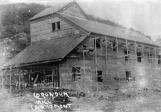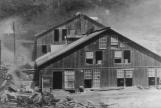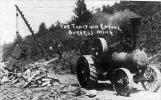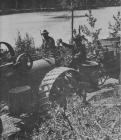9
In 1944, with a new demand for the ore for industries during WWII, a new mine building was constructed in May of that year and corundum was milled until 1946 producing 200 tons a day from the tailings. Bill Kelly was the boss.The mine consisted of a drilled horizontal mine of approximately 220 feet into Robillard Mountain as well as several 'open pit' sites up the side of the mountain. The mine is now home to thousands of bats. These sites can be easily explored today. As well, several concrete and stone construction partial buildings can be seen.
There were four fatalities at the mine in the early years. They were Bill Tracey, Mr. Mulfantine in 1908, Mr. Canon in February 1913 and Jim Regan on July 27, 1946.
Today, Craigmont and Burgess Mines are essentially ghost towns. There is only one of the original buildings left at Craigmont and that is a stable once owned by the Regan family and now home to a reclusive monk. After the mine closed, many of the miners and families went north to other mine areas such as Cobalt and the homes were either destroyed or moved nearby.
This is the story of the once largest corundum mine in the world!
11
The Burgess Mine StoryIn 1902, the Ontario Corundum Company took up the Burgess Mine on Lot 14, Concession 14, Carlow Twp. originally investigated by W. F. Ferrier, a Lithologist. He was with the Geological Survey of Canada. In that first year ore was hand sorted and processed by a small blade crusher and produced 15% corundum for shipment to the USA for further concentration.
The next year a new mill was built but it burned in 1904 and was replaced by a larger structure with a lot of heavy processing equipment. Power was supplied by a 75 H.P. horizontal boiler using vast amounts of locally cut wood. From the mine cut, carts hauled the ore to the mill by a steam tractor for processing. All the processed ore was teamed to a wharf on the York River during summer months to be transported by the steamer 'Mayflower' towing barges with bags of processed corundum and other steamer boats to the rail depot at Barry’s Bay. In the winter the ore was placed in cages and sleighs and transported up the frozen York River to the Palmer Rapids road and then onto the old Barry’s Bay road to the hamlet of Halfway. There, the team of horses and driver changed before taking the corundum to the train in Barry’s Bay. Halfway got it’s name because it was halfway from Craigmont/Burgess Mines to Barry’s Bay. Many people believe to this day it was halfway between Combermere and Barry’s Bay, which is incorrect.
13
There was a small community near Burgess Mill where many of the workers and families lived. Many more workers who lived in other parts of Carlow Township would walk to their homes on days off and boarded in the community during the week. Approximately 150 miners worked in the mine and mill operation.There were some fatalities at the Burgess Mine. In 1915 Martin Canon was killed in an explosion in the plant boiler room while he was shoeing a horse. Two years later John Young died accidentally when his deer rifle discharged piercing his chest cavity as he hunted near the mine.
As an indication of how great a gamble farming was in those days, one night 25 sheep from a homesteader were either killed by wolves or so badly mauled they had to be destroyed. Foxes were a constant threat to both chickens and turkeys and a family lost a horse struck by lightning.
15
In 1905, the Burgess operation was taken over by the Ashland Emery and Corundum Company. However, the quality and quantity of corundum was not good so a new deposit was worked two miles north near Grady Lake.Early in 1910 the Armstrong Corr Company Ltd. leased the Burgess plant but after two months operation the Manufacturer’s Company, already running the Craigmont Mill four miles to the east took over from them and crude concentrate from the Burgess Mine was reprocessed and finished at Craigmont.
Mr. Santz was the first manager, and he was succeeded by Wilson Mackey. Among the foremen were William Kelly, Fred Cone and Joseph Chidley. Kelly also worked at Craigmont and was known as 'Klondike' Kelly because he previously worked in the Yukon Gold Rush.
17
After the February 3, 1913 fire that totally destroyed the Craigmont Mill, some of the machinery that was salvaged was moved to the Burgess Mine and company teams drew Craigmont’s wood supply that had escaped the blaze. The office staff was also moved and James Scott who kept the Craigmont Company Store transferred his operations to Burgess.The Burgess Mine operation continued to produce corundum until 1918 when the mill closed down due to a lack of demand. A synthetic substitute known as 'Carborundum' spelled the end of the Burgess Mine as a viable economic enterprise.






